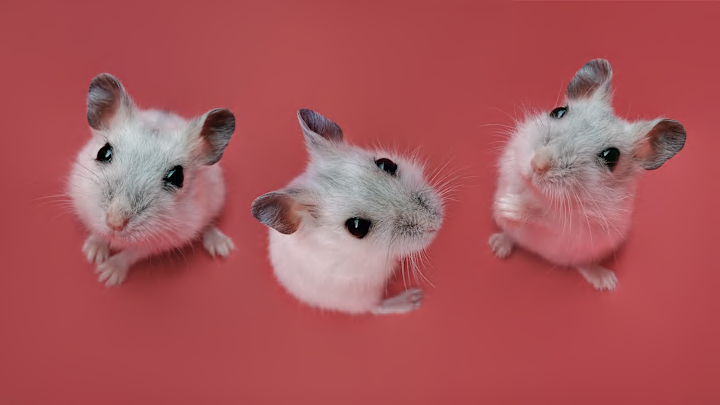As far as pets go, hamsters are pretty beloved. But how much do you really know about these tiny furballs? We’ve rounded up some fascinating hamster facts below.
1. Syrian hamsters can hold their alcohol.
Syrian hamsters (also known as golden hamsters) live in dry habitats from southern Turkey to northern Syria. They store fruit in the summer and live off it during the winter months. The only problem with this? By the time they get to it, the fruit has fermented. To eat it, the hamsters have developed comparatively large livers that allow them to metabolize alcohol quickly. This makes these hamsters great specimens for studies on alcohol.
2. Not every kind of hamster would be a good pet.
Although there are about 24 species of hamster, only about five of them are found in a typical pet store. These five are Roborovski hamsters (commonly called Robo hamsters), Syrian hamsters, Russian dwarf winter white hamsters, Chinese hamsters, and Campbell’s dwarf hamsters.
3. Most hamsters are solitary to a fault.

Hamsters value their personal space, to the point that they will sometimes fight other hamsters to the death if they invade their territory. Syrian hamsters are especially guilty of this, but there are some exceptions. Robo hamsters can be kept in pairs with other Robo hamsters, but it’s best if they’re related—otherwise, it can be very hard to introduce them to each other. There are a few other breeds that can be kept together as well, with varying degrees of success.
4. Hamsters don’t inspire great art.
Yes, we’re talking about the infamous “Hampster Dance.” It was ranked #79 on a list of the 100 Worst Songs Ever, and was called “the grandfather of today’s Rickroll.”
5. Hamsters are great at reproducing ...
At 16 to 30 days, the hamster’s gestation cycle is one of the shortest in the mammalian class. But if birth conditions aren’t right, they can delay birth by as many as nine days. Also, once a hamster gives birth, it can get pregnant again within 24 hours.
6. … But their parenting skills are kind of iffy.

Mother hamsters have been known to eat their young or end their pregnancy if the father isn’t around. Most believe hamsters do this when the litter is too big to make sure they have the resources necessary for the remaining babies.
7. Hamsters aren’t actually nocturnal.
While some are especially energetic at night, the small mammals are generally crepuscular, which means they’re most active during twilight hours. Experts say that they’re probably that way because that’s when the insects that are a natural part of their diet are most active. Plus, the light is lower, meaning they’re less likely to get caught by predators. Hamsters aren’t the only crepuscular mammals—wallabies, bobcats, bears, and even many house cats and stray dogs follow the same pattern.
Read More About Animals Here:
8. Their wheel might actually be bad for them.
Hamsters love to run, and pet hamsters most commonly run on little wheels in their cages. But if their wheels are too small, they can cause pain, spinal problems, and even lead to arthritis. Some hamsters flat out refuse to use a wheel that’s too small, leading to unhealthy levels of inactivity. Wheels made with mesh or bars can also be bad for them, because they can get stuck or hurt. (A list of safer options for hamster owners can be found here.)
9. Their name says it all.

Hamster comes from the German word hamstern, which means “to hoard.” Even domesticated hamsters will hoard, despite the fact that they don’t need to.
10. Some species of hamster are threatened in the wild.
Not all hamsters fall under this category, but Syrian hamsters are considered vulnerable due to human development in their natural habitats. During the 1980s, wild Syrian hamsters were thought to be extinct, but some were found and caught in 1997 and 1999.
11. Hamsters have really bad eyesight.
After hamsters are born, it’s nearly two weeks before they’ll open their eyes—but even then, they’re at a disadvantage, because they’re nearsighted and colorblind. To compensate, they use their whiskers and their sense of smell to navigate.
A version of this story originally ran in 2015; it has been updated for 2024.
